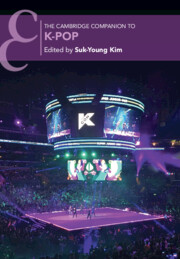Book contents
- The Cambridge Companion to K-Pop
- Cambridge Companions to Music
- The Cambridge Companion to K-Pop
- Copyright page
- Contents
- Figures
- Tables
- Contributors
- Acknowledgments
- Notes to Readers
- Introduction
- Part I Genealogies
- 1 Sticking It to the Man
- 2 Itaewon Class, Gangnam Style, and Yeouido Star
- Part II Sounding Out K-Pop
- Part III Dancing to K-Pop
- Part IV The Making of Idols
- Part V The Band That Surprised the World
- Part VI Circuits of K-Pop Flow
- Index
- References
1 - Sticking It to the Man
Early Neoliberalism in Korean Pop Music
from Part I - Genealogies
Published online by Cambridge University Press: 02 March 2023
- The Cambridge Companion to K-Pop
- Cambridge Companions to Music
- The Cambridge Companion to K-Pop
- Copyright page
- Contents
- Figures
- Tables
- Contributors
- Acknowledgments
- Notes to Readers
- Introduction
- Part I Genealogies
- 1 Sticking It to the Man
- 2 Itaewon Class, Gangnam Style, and Yeouido Star
- Part II Sounding Out K-Pop
- Part III Dancing to K-Pop
- Part IV The Making of Idols
- Part V The Band That Surprised the World
- Part VI Circuits of K-Pop Flow
- Index
- References
Summary
K-pop formations are believed to have drawn inspiration from Seo Taiji and Boys, who arrived in the early 1990s and became a cultural phenomenon before disbanding in 1996. They offered a unique blend of melodic tunes, heavy beats, short raps, and synchronized dance sequences that drew on hip hop, rock, and disco. They transformed Korean music and fashion and had a profound effect on young Koreans’ sense of identity and national pride. However, despite the band’s pioneering role, it did not provide a blueprint for the business model of K-pop today. Partly in response to the decline in record sales, today’s reliance on concert tours, marketing media, and talent shows developed later. But the formulas themselves are not entirely new to Korean pop music. This chapter explores talent shows organized in the 1930s and 1940s. Although the conditions of pop music were different then, the early prevalence of the shows demonstrates that public auditions, competition, and audience participation took root early on. Focusing on the symptomatic ethos, signs, and practices of neoliberalism, rather than retrofitting the neoliberal era to the 1930s, the author contends that the music industry recognized by then that neoliberal attributes can be a powerful marketing ploy.
- Type
- Chapter
- Information
- The Cambridge Companion to K-Pop , pp. 11 - 27Publisher: Cambridge University PressPrint publication year: 2023

